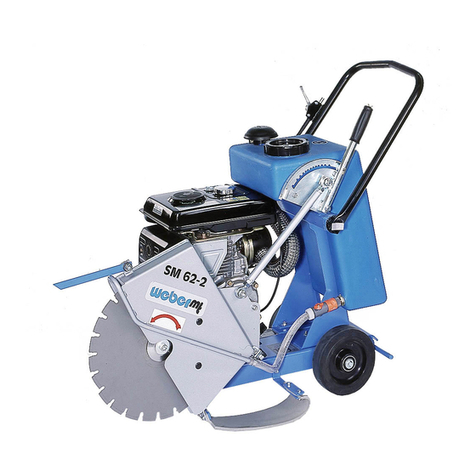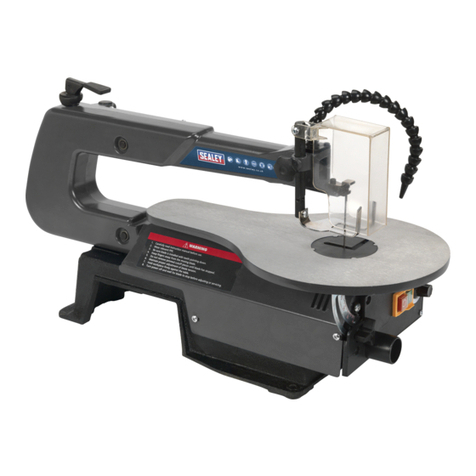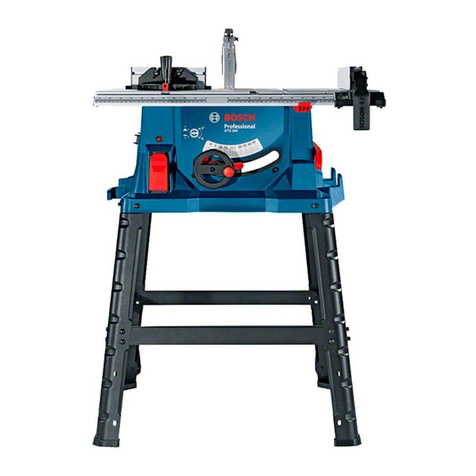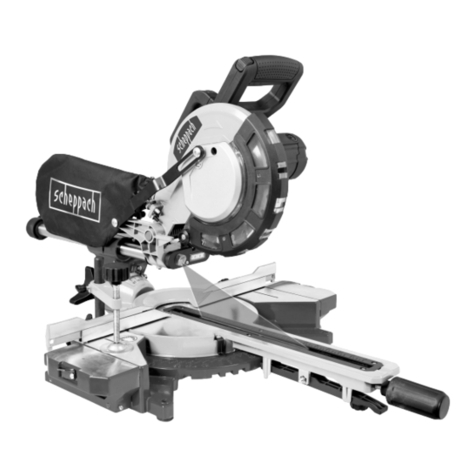Timber Tuff Tools TMW-3228SMBS User manual

Saw Mill
OWNER’S MANUAL
02072022
WARNING:
Read carefully and understand all ASSEMBLY AND OPERATION INSTRUCTIONS before
operating. Failure to follow the safety rules and other basic safety precautions may result in
serious personal injury.
Model # TMW-3228SMBS

2
Thank you very much for choosing this product! For future reference, please complete the owner’s record
below:
Model: TMW-3228SMBS Purchase Date: _______________
Save the receipt, warranty and these instructions. It is important that you read the entire manual to become
familiar with this product before you begin using it.
This product is designed for certain applications only. The manufacturer cannot be responsible for issues
arising from modification. We strongly recommend this product not be modified and/or used for any
application other than that for which it was designed. If you have any questions relative to a particular
application, DO NOT use the product until you have first contacted us to determine if it can or should be
performed on the product.
For technical questions please call 1-218-943-6290.
INTENDED USE
The Timber Tuff Saw Mill is portable and versatile which makes it a great tool for any lumber project. It has the
capabilities of sawing logs up to 32” in diameter, 4-1/2" thick and a cutting length of 10'-5". It is equipped with a
420cc Briggs & Stratton Engine and Blades with a blade speed of 3279 fpm.
TECHNICAL SPECIFICATIONS
Item
Description
Capacity
32” diameter, 4-1/2" thick,10'-5" in length
Engine
Briggs & Stratton 420cc
Blade
156”×1-1/4”×.035 ×1.1tpi
Dimensions
161-2/5” x 77” x 92”
GENERAL SAFETY RULES
WARNING: Read and understand all instructions. Failure to follow all instructions listed below may
result in serious injury.
CAUTION: Do not allow persons to operate or assemble this saw mil until they have read this
manual and have developed a thorough understanding of how the saw mill works.
WARNING: The warnings, cautions, and instructions discussed in this instruction manual
cannot cover all possible conditions or situations that could occur. It must be understood by the operator
that common sense and caution are factors which cannot be built into this product, but must be supplied by the
operator.

3
SAVE THESE INSTRUCTIONS
WORK AREA
•Keep work area clean, free of clutter and well lit. Cluttered and dark work areas can cause accidents.
•Keep children and bystanders away while operating the saw mill. Distractions can cause you to lose
control, so visitors should remain at a safe distance from the work area.
•Be alert of your surroundings. Using a saw mill in confined work areas may put you dangerously close to
cutting tools and rotating parts.
PERSONAL SAFETY
•Stay alert, watch what you are doing and use common sense when using a saw mill. Do not use a saw mill
while you are tired or under the influence of drugs, alcohol or medication. A moment of inattention while
operating a saw mill may result in serious personal injury.
•Dress properly. Do not wear loose clothing, dangling objects, or jewelry. Keep your hair, clothing and
gloves away from moving parts. Loose clothes, jewelry or long hair can be caught in moving parts.
•Use safety apparel and equipment. Use safety goggles or safety glasses with side shields which comply
with current national standards, or when needed, a face shield. Use a dust mask if working in dusty work
conditions. This applies to all persons in the work area. Also use non-skid safety shoes, hardhat, heavy-
duty work gloves, dust collection systems, and hearing protection when appropriate.
SAW MILL USE AND CARE
•Do not modify the saw mill in any way. Unauthorized modification may impair the function and/or safety
and could affect the life of the equipment. There are specific applications for which the saw mill was
designed.
•Always check for damaged or worn out parts before using the saw mill. Broken parts will affect the
saw mill operation. Replace or repair damaged or worn parts immediately.
•Do not exceed the saw mill load capacity.
•Distribute the load evenly. Uneven loads may cause the saw mill to tip, resulting in personal injury to the
operator or others. Log should be secured before sawing.
•Use the saw mill on flat and level surfaces capable of supporting the saw mill and its maximum load.
Pulling or pushing a load on a slanted or uneven surface can result in loss of control. Saw mill needs to be
on a flat and level surface before sawing.
•Store idle saw mill. When saw mill is not in use, store it in a secure place out of the reach of children.
Inspect it for good working condition prior to storage and before re-use.

4
IMPORTANT SAFETY INFORMATION
WARNING! Read all instructions.
Failure to follow all instructions listed below may result in fire, serious injury and/or
DEATH. The warnings and precautions discussed in this manual cannot cover all possible
conditions and situations that may occur. It must be understood by the operator that common
sense and caution are factors which cannot be built into this product, but must be supplied by the
operator.
SAVE THESE INSTRUCTIONS
Set Up Precautions
1. Gasoline fuel and fumes are flammable, and potentially explosive. Use proper fuel storage and handling
procedures. Do not store fuel or other flammable materials near the machine.
2. Have fire extinguishers nearby.
3. Operation of this equipment may create sparks that can start fires around brush and dry vegetation. A
spark arrestor may be required. The operator should contact local fire agencies for laws or regulations
relating to fire prevention requirements.
4. Set up and use only on a flat and level surface. Area must be well ventilated.
5. Wear ANSI-approved safety goggles, heavy-duty work gloves, and dust mask/respirator during set up.
6. Use only lubricants and fuel recommended in the engine manual or in the Specifications chart of this
manual.
Engine Precautions
Follow engine precautions and instructions in the included engine instruction manual.
Operating Precautions
CARBON MONOXIDE HAZARD
Using an engine indoors CAN KILL YOU IN MINUTES.
Engine exhaust contains carbon monoxide. This is a poison you cannot see or smell.
NEVER use indoors
EVEN IF doors and window are open.
Only use OUTSIDE and far away from windows, doors
and vents.
1. Keep children and bystanders away from the equipment, especially during operation.
2. Do not leave the equipment unattended when it is running. Turn off the equipment (and remove safety keys,
if available) before leaving the work area.
3. Wear ANSI-approved safety glasses, hearing protection, and NIOSH-approved dust mask/respirator under a
full face shield during use. Wearing steel toe shoes is also recommended.

5
4. Wear heavy-duty work gloves when handling the blades.
5. People with pacemakers should consult their physician before use. Electromagnetic fields in close proximity
to a heart pacemaker could cause pacemaker interference or pacemaker failure. Caution is necessary
when near the engine’s magneto or recoil starter.
6. Use only accessories that are recommended by Timber Tuff for your model. Accessories that may be
suitable for one piece of equipment may become hazardous when used on another piece of equipment.
7. Do not operate in explosive atmospheres, such as in the presence of flammable liquids, gases, or dust.
Gasoline-powered engines may ignite the dust or fumes.
8. Stay alert, watch what you are doing and use common sense when operating this piece of equipment. Do
not use this piece of equipment while tired or under the influence of drugs, alcohol or medication.
9. Do not overreach. Keep proper footing and balance at all times. This enables better control of the
equipment in unexpected situations.
10. Dress properly. Do not wear loose clothing or jewelry. Keep hair, clothing and gloves away from
moving parts. Loose clothes, jewelry or long hair can be caught in moving parts.
11. Parts, especially exhaust system components, get very hot during use. Stay clear of hot parts.
12. Do not cover the engine or equipment during operation.
13. Keep the equipment, engine, and work area clean at all times.
11. Use the equipment, accessories, etc., in accordance with these instructions and in the manner intended for
the particular type of equipment, taking into account the working conditions and the work to be performed.
Use of the equipment for operations different from those intended could result in a hazardous situation.
12. Do not operate the equipment with known leaks in the engine's fuel system.
13. WARNING: The brass components of this product contain lead, a chemical known to the State of California
to cause birth defects (or other reproductive harm). (California Health & Safety code § 25249.5, et seq.)
14. WARNING: Some dust created by power sanding, sawing, grinding, drilling, and other construction
activities, contains chemicals known [to the State of California] to cause cancer, birth defects or other
reproductive harm. Some examples of these chemicals are:
Lead from lead-based paints
Crystalline silica from bricks and cement or other masonry products
Arsenic and chromium from chemically treated lumber
Your risk from these exposures varies, depending on how often you do this type of work. To reduce your
exposure to these chemicals: work in a well ventilated area, and work with approved safety equipment, such as
those dust masks that are specially designed to filter out microscopic particles. (California Health & Safety Code
§ 25249.5, et seq.)
15. This product contains or, when used, produces a chemical known to the State of California to cause cancer
and birth defects or other reproductive harm. (California Health & Safety Code § 25249.5, et seq.)
16. When spills of fuel or oil occur, they must be cleaned up immediately. Dispose of fluids and cleaning
materials as per any local, state or federal codes and regulations. Store oil rags in a bottom-ventilated,
covered, metal container.
17. Keep hands and feet away from moving parts. Do not reach over or across equipment while operating.
18. Before use, check for misalignment or binding of moving parts, breakage of parts, and any other condition that
my affect the equipment’s operation. If damaged, have the equipment serviced before using. Many accidents
are caused by poorly maintained equipment.

6
19. Use the correct equipment for the application. Do not modify the equipment and do not use the equipment for
a purpose for which it is not intended.
20. Keep hands and feet away from moving parts. Do not reach over or across equipment while operating.
21. Before use, check for misalignment or binding of any moving parts, breakage of parts, and any other condition
that may affect the equipment’s operation. If damaged, have the equipment serviced before using. Many
accidents are caused by poorly managed equipment.
22. Use the correct equipment for the application. Do not modify the equipment and do not use the equipment
for a purpose for which it is not intended.
Service Precautions
1. Before service, maintenance or cleaning:
a. Turn the engine switch to its “OFF” position.
b. Allow the engine to completely cool
c. Then remove the spark plug wire(s) from the spark plug(s).
2. Keep all safety guards in place and in proper working order. Safety guards include muffler, air cleaner,
mechanical guards and heat shields, among other guards.
3. Do not alter or adjust any part of the equipment or its engine that is sealed by the manufacturer or
distributor. Only a qualified service technician may adjust parts that may increase or decrease
governed engine speed.
4. Wear ANSI-approved safety goggles, heavy-duty work gloves, and dust mask/respirator during service.
5. Maintain labels on the equipment. These carry important information. If unreadable or missing, contact
Timber Tuff for a replacement.
6. Have the equipment serviced by a qualified repair person using only identical replacement parts. This will
ensure that the safety of the equipment is maintained. Do not attempt any service or maintenance
procedures not explained in this manual or any procedures that you are uncertain about your ability to
perform safely or correctly.
7. Store equipment out of the reach of children.
8. Follow scheduled engine and equipment maintenance.
9. Refueling:
a. Do not smoke, or allow sparks, flames, or other sources of ignition around the equipment, especially
when refueling.
b. Do not refill the fuel tank while the engine is running or hot.
c. Do not fill fuel tank to the top. Leave a little room for the fuel to expand as needed.
d. Refuel in a well-ventilated area only.
Specifications
Fuel Type
87+ octane unleaded gasoline
Fuel Capacity
1.74 Gallon
Blade Speed
3,279 FPM
Log Diameter
32” Maximum
Board Width
26” Maximum
Cutting Thickness
4-1/2” Maximum
Cutting Length
10'-5" Maximum (125”)
Note: Engine specifications are found in the engine manual supplied with this equipment.
TO PREVENT SERIOUS INJURY:
Operate only with proper spark arrestor installed. Operation of this equipment may create sparks that can
start fires around dry vegetation and brush. A spark arrestor may be required.
The operator should contact local fire agencies for laws or regulations relating to fire prevention requirements.
TO PREVENT SERIOUS INJURY: The Saw Mill is dangerous if assembled incorrectly.
If you do not feel completely comfortable assembling it, then have a qualified technician assemble it.

7
Assembly
Read all of the safety precautions and warnings in this manual before setting up
or using this product.
TO PREVENT SERIOUS INJURY:
Operate only with proper spark arrestor installed. Operation of this equipment may create sparks that can
start fires around dry vegetation and brush. A spark arrestor may be required.
The operator should contact local fire agencies for laws or regulations relating to fire prevention requirements.
TO PREVENT SERIOUS INJURY: The Saw Mill is dangerous if assembled incorrectly.
If you do not feel completely comfortable assembling it, then have a qualified technician assemble it.
OPERATING INSTRUCTIONS
Read all of the safety precautions and warnings in this manual before setting up or
using this product.
Engine Operation
Inspect engine and equipment looking for damaged, loose or missing parts before operating.
If any problems are found, do not use equipment until fixed properly.
Start Procedure
Before starting the engine:
a. Follow the Set Up Instructions to prepare the equipment. Follow all instructions in
The separate engine manual provided with the engine.
b. Inspect the equipment and engine.
c. Fill the engine with the proper amount and type of fuel and oil.
d. Read the Equipment Operation section that follows.
1. Start and operate the engine according to the provided engine manual.
2. Replacement engine operating instructions can be obtained from the engine manufacturer.

8
ASSEMBLY:
1. Open the package cover and take out the parts of the equipment for use.
The two long boxes at the bottom of the packing box are rail components.
Take out the bolts and nuts inside to install the rails. Refer to exploded
diagram 1
a: Place the track (7) as shown in the figure, and fix it with hex flange
bolts (13) and hex flange nuts (15). The outer diameter of the guide rail
is 1008.5mm. Use a meter ruler to measure the dimensions of each section of
the guide rail. After adjusting the size, tighten the nut with a wrench.
b: Install 2 sets of end stop (3) on the front and rear ends of the guide
rail, and tighten them with hex bolts (4) and nuts (2).

9
c:Fix the wood tightening device with hex flange bolts (13) and hex flange
nuts (15), and install threaded plates (18) on the threads. There are 5
threaded plates in the small white box, of which the middle of center
support (8) is a total of 2 One piece is used for the middle center support
(12) of the guide rail, and two pieces are used for rocker tube sleeve (17).
d:The bottom of the guide rail is equipped with 12 guide track adjustment
frame (6), which can be selected according to the flatness of the ground.
The equipment is equipped with two material blocking pipes each in length,
and a suitable set of blocking pipes can be selected according to the

10
diameter of the wood when working. The drawing number of the short log
support(9), and the drawing number of the long log support (10).
e: Install a guide rail connecting plate (25) on each side of the middle
joint of the guide rail, and fix it with hex flange bolts (13) and hex
flange nuts (15).
2. Take out the two sets of legs weldments (28) and the front square
tube(26) and back square tube (45), lift the main body of the equipment
on the two sets of legs, then insert the front square tube (26), and
use the hex bolts (27) to flat washer (37) The hex nut (38) is fixed,
and the rear tube (45) is fixed in the same way.

11
3. Install the pushing handle (46). As shown in the figure, it is fixed in
the right back square tube (45). The height of the armrest can be adjusted
to a suitable position according to the user's operating habits.
4. Install the upper assembly. Place the upper assembly on the top of the
four square pipes as shown in the figure, then install the front frame
(120) and scale support plate (134), align the bolt holes, and use the

12
hex bolts (133) ,hex bolts (27), flat washers (37) and hex nuts ( 38)
Fixed.
The pulley (161) is fixed on the long hex bolt (133) at the lower end of the
front square tube (26) (refer to the exploded figure 5).
5. After fixing, use a wrench to tighten the bolt.
Then tighten the bolt pointed by the arrow.

13
6. Install the scale plate (119), scale plate (front) (132) and rivet (116)
as shown in the figure. Refer to the picture for illustration.
The water pipe at the lower end of the water tank is installed on the saw
block pushing tube (54). Before installation, the bolt pointed to by the
arrow in the figure must be loosened, and the water pipe will pass through
before tightening.

14
During work, adjust the size of the water valve (124) so that the water flow
is sprayed on the saw blade (97) to cool the saw blade.
7. Install two wire ropes as shown in the figure. One end of the wire rope
is hung on the lifting arm weldments (157), and the other end is hung
on the steel wirerope screw(164) on the frame. Please refer to the
picture and schematic diagram for installation of the wire rope.

15
After the wire rope is hung, the height adjustment arm (140) can be turned
to raise the large pulley cover (machine body).
Rotate the height adjustment arm (140) clockwise to raise the band saw, and
turn counterclockwise to lower it.

16
If the wheel cover is found to be uneven during the lifting process, first
drop the large saw cover to the bottom, and adjust the up and down distance
of the steel wirerope screw (164) at the left and right ends until the saw
cover is level after being raised.
The height adjustment arm (140) has a locking function. When in use, you can
turn the locking switch(142) to make the pin (146) fit into one of the holes
of the rotary table (150) to lock the crank Put the height adjustment arm
(140).

17
The gasoline engine equipped with the saw is an electric starter, and
customers can add a battery to start the gasoline engine. There is a place
for installing the battery on the equipment, which is convenient for
customers to install.
8. After the main body of the band saw machine is placed on the guide rail,
take out the 4 guide guide brush (29) from the manual bag and install
them in the brush groove of the leg weldments (28).
At this point, the big saw is installed.

18
Equipment Operation
1. Wear heavy-duty work gloves, ANSI-approved goggles behind a full face shield, steel-toed work boots, and
a dust mask.
2. Operate only with the assistance of another qualified person.
3. Fill the Water Tank with clean water.
4. The maximum log diameter that can be cut is 32”. The maximum board width that can be cut is 26”
The log must be at least 3’ 8” long and must rest on at least two Supports (8, 12) to prevent
instability.
5. Cut branches off the log to be processed before sawing.
6. Do not cut logs containing foreign objects (nails, metal, etc.). This will cause Blade damage and could cause
serious injury.
7. Choose the Short Log Supports (9) or the Long Log Supports (10) according to the log diameter.
8. Place the log to be cut on the Supports. See Figure T. Brace the log against the Log Supports (10 or 9) to
prevent movement during sawing. The log should be positioned so that the force of cutting holds it against
the supports. Log supports (9 or 10) need to be lower than the thickness of the board being cut to avoid
blade damage.
9. Clamp the log in place against the Log Supports (10 or 9) using the Log Clamp Assembly (20) in the location
shown in Figure T.
10. Tighten all Bolts and T-Handles on the Log Clamp Assembly (20) and the Log Supports (10 or 9). Verify that
they are securely in place before proceeding.
NOTE: Make sure the Log Clamp Assembly (20) does NOT interfere with the Saw Blade when
sawing. The Log Clamp Assembly (20) should be lower than the Saw Blade at all times.
Clamp Log
Here (20)
Log on
Supports
(9 or 10)
Figure T: Lumber Position
Scale Pointer
Scale
Pointer
Knob
Scale
Height Adjustment
Handle
Figure U: Scale and Scale Pointer

19
11. Align the Blade with the top of the log, loosen the Scale Pointer Knob and adjust the Scale Pointer to point at
0” on the Scale. Tighten the Scale Pointer Knob.
12. Release both Thread Plate (18). Turn the Height Adjustment Handle (137) and adjust the cutting height until
the Scale Pointer points to the desired thickness. Engage both Thread Plate (18).
13. The cut direction must be as shown below. If the log is cut from the other direction, the saw blade will push
the log away from the supports and may cause the log to become unstable.
14. WARNING! All operators must stay clear of the front and back of the blade whenever the engine is
running.
15. Start and operate the engine according to the provided engine manual.
16. Adjust the Throttle to bring the Blade up to speed. The Locking Ring can be turned to lock the throttle in
place.
17. Throttle speed may need to be increased when the Saw is under load.
18. Move the Saw Head slowly along the track and against the log to make the cut.
NOTE: Repeated adjustments will need to be made during cutting.
19. Shut off engine if blade binds, breaks, or another problem is suspected. Do not try to back the blade
out of the log while engine is running.
20. Trim off the rounded sides of the lumber
21. After the log is squared-off, boards or posts can be cut.
Figure V: Direction of Cut
Locking Ring
Throttle Lever
Figure W: Throttle Control
End of Cut
Start of Cut

20
22. To prevent accidents, turn off the engine and disconnect its spark plug wire after use. Wait for the engine to
cool, clean external parts with clean cloth, then store the equipment out of children’s reach according to the
Store instructions in this manual.
Servicing
TO PREVENT SERIOUS INJURY FROM ACCIDENTAL STARTING:
Turn the power Switch of the equipment to its “OFF” position, wait for the engine to cool, and disconnect the spark
plug wire(s) before performing any inspection, maintenance or cleaning procedures.
TO PREVENT SERIOUS INJURY FROM EQUIPMENT FAILURE:
Do not use damaged equipment. If abnormal noise, vibration or excess smoking occurs, have the problem corrected
before further use.
Maintenance Procedures
Many maintenance procedures, including those not detailed in this manual, will need to be
performed by a qualified technician for safety. If you have any doubts about your ability to
safely service the equipment or engine, have a qualified technician service the equipment.
NOTE: These procedures are in addition to the regular checks and maintenance explained as part of the regular
operation of the engine and equipment.
Engine Maintenance and Service
Follow the instruction found in the included engine manual.
Equipment Lubrication
1. Lubricate the Band Wheel Axles and Square and Round Posts with machine oil before each use.
2. Lubricate the Tension Handle with grease monthly or as needed.
Storage
1. Wait for engine to cool, then clean equipment with clean cloth.
2. Clean the engine and/or prepare it for storage according to engine manual instructions.
3. Apply a thin coat of rust preventive oil to all uncoated metal parts.
4. Cover and store in dry, well-ventilated area out of reach of children.
5. For cold weather operation, store the equipment in a cool dry area to prevent condensation and premature
wear.
Table of contents
Popular Saw manuals by other brands

Makita
Makita DLS713 instruction manual
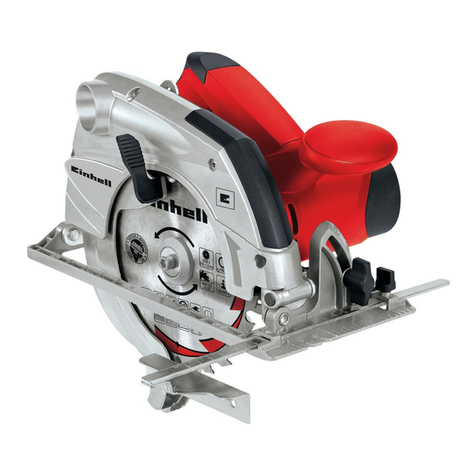
EINHELL
EINHELL TH-CS 1600 Original operating instructions

Metabo
Metabo KGS 216 Original instructions

Chicago Electric
Chicago Electric 69480 Owner's manual & safety instructions

Bosch
Bosch PKS 54 Original instructions

Milwaukee
Milwaukee M12 FBS64 Original instructions

Chicago Electric
Chicago Electric 44829 Set up and operating instructions

Ryobi
Ryobi SC164VS Manuel d'utilisation
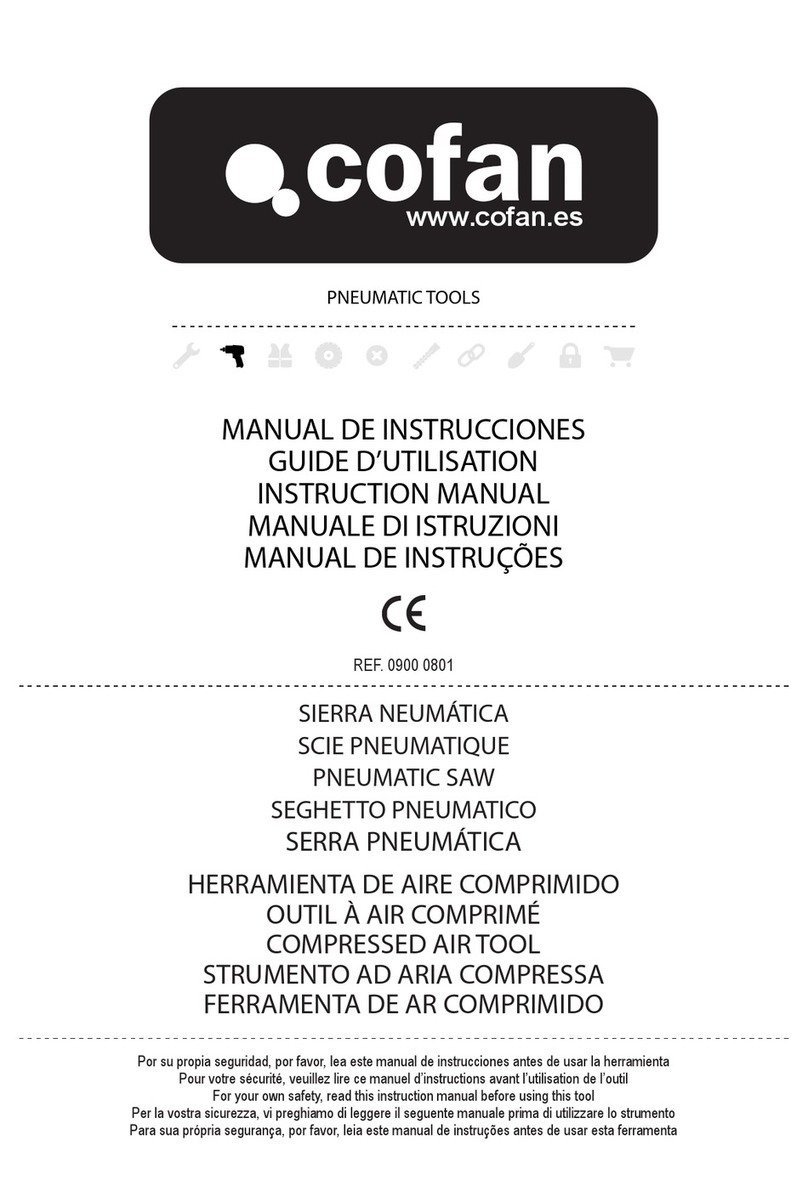
COFAN
COFAN 0900 0801 instruction manual

Stanley
Stanley STSM1525 instruction manual

Bosch
Bosch GSA 18 V-LI Professional Original instructions

Bosch
Bosch Professional GSA 12V-14 Original instructions

